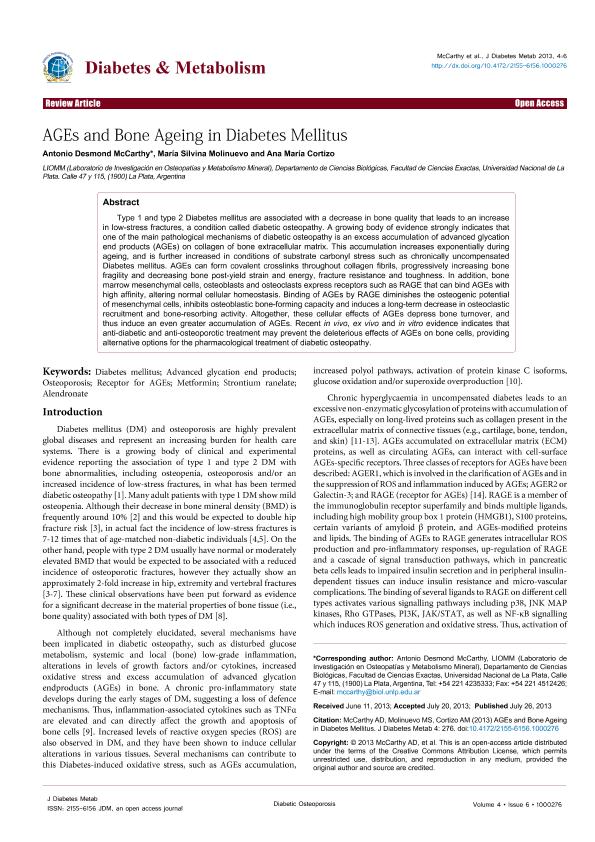Artículo
AGEs and Bone Ageing in Diabetes Mellitus
Fecha de publicación:
07/2013
Editorial:
OMICS International
Revista:
Journal of Diabetes and Metabolism
ISSN:
2155-6156
Idioma:
Inglés
Tipo de recurso:
Artículo publicado
Clasificación temática:
Resumen
Type 1 and type 2 Diabetes mellitus are associated with a decrease in bone quality that leads to an increase in low-stress fractures, a condition called diabetic osteopathy. A growing body of evidence strongly indicates that one of the main pathological mechanisms of diabetic osteopathy is an excess accumulation of advanced glycation end products (AGEs) on collagen of bone extracellular matrix. This accumulation increases exponentially during ageing, and is further increased in conditions of substrate carbonyl stress such as chronically uncompensated Diabetes mellitus. AGEs can form covalent crosslinks throughout collagen fibrils, progressively increasing bone fragility and decreasing bone post-yield strain and energy, fracture resistance and toughness. In addition, bone marrow mesenchymal cells, osteoblasts and osteoclasts express receptors such as RAGE that can bind AGEs with high affinity, altering normal cellular homeostasis. Binding of AGEs by RAGE diminishes the osteogenic potential of mesenchymal cells, inhibits osteoblastic bone-forming capacity and induces a long-term decrease in osteoclastic recruitment and bone-resorbing activity. Altogether, these cellular effects of AGEs depress bone turnover, and thus induce an even greater accumulation of AGEs. Recent in vivo, ex vivo and in vitro evidence indicates that anti-diabetic and anti-osteoporotic treatment may prevent the deleterious effects of AGEs on bone cells, providing alternative options for the pharmacological treatment of diabetic osteopathy.
Archivos asociados
Licencia
Identificadores
Colecciones
Articulos(CCT - LA PLATA)
Articulos de CTRO.CIENTIFICO TECNOL.CONICET - LA PLATA
Articulos de CTRO.CIENTIFICO TECNOL.CONICET - LA PLATA
Citación
McCarthy, Antonio Desmond; Molinuevo, Maria Silvina; Cortizo, Ana María; AGEs and Bone Ageing in Diabetes Mellitus; OMICS International; Journal of Diabetes and Metabolism; 4; 6; 7-2013; 1-8; 1000276
Compartir
Altmétricas




